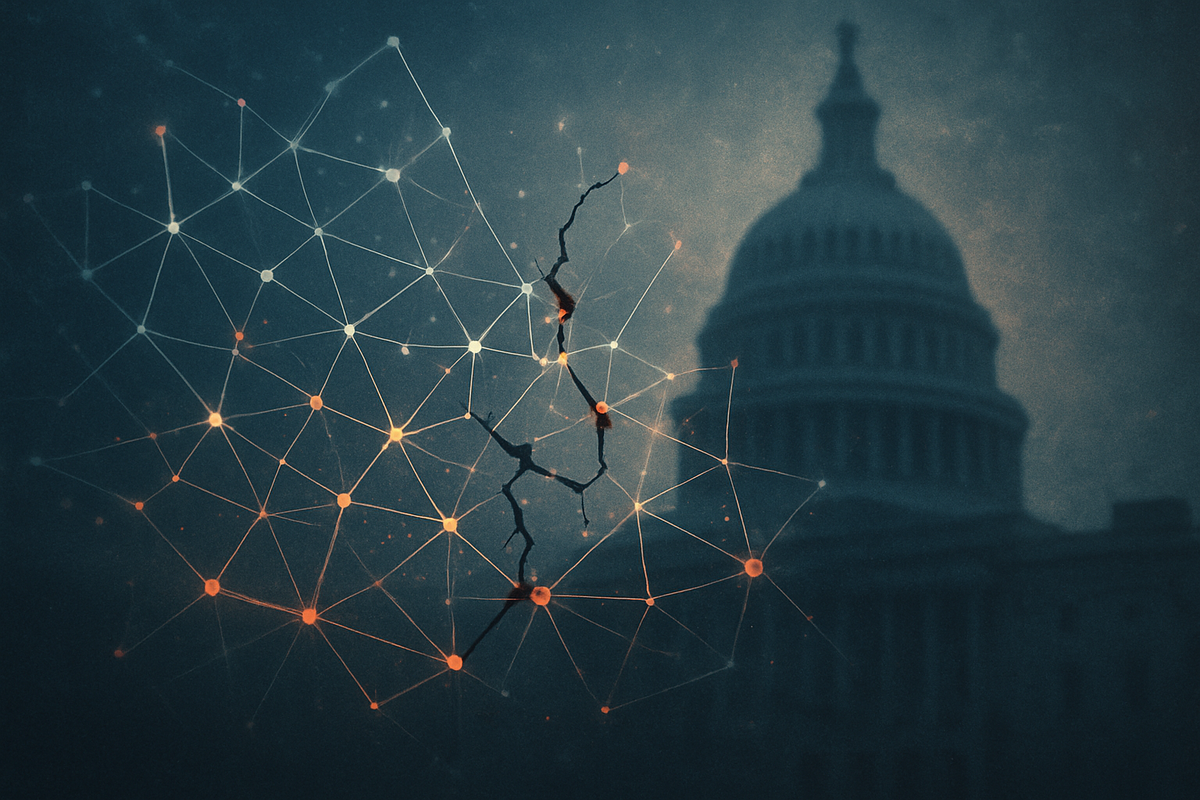
Washington D.C., November 12, 2025 – The recent, prolonged U.S. government shutdown, spanning a record-setting duration, has inflicted a significant and potentially lasting scar on the nation's economic data landscape. This unprecedented disruption has not only curtailed essential government services and left millions of federal workers without pay but has also plunged policymakers and investors into a "data vacuum," severely complicating the ability to make informed, data-driven decisions regarding the health and trajectory of the U.S. economy. The long-term implications of this sustained data blackout are profound, threatening to undermine market confidence and hinder effective economic analysis for months, if not years, to come.
The immediate fallout has been a cascade of economic uncertainty, as critical statistical agencies ceased operations, halting the release of vital economic indicators. This absence of timely and reliable information leaves the Federal Reserve, businesses, and investors "flying blind," struggling to accurately assess the current economic climate or anticipate future trends. The "lasting scar" refers not just to the immediate economic losses, but to the potential for permanent gaps in historical data, which could compromise future analyses and policy effectiveness.
A Nation in the Dark: Unpacking the Shutdown's Grip on Data and Markets
The recent government shutdown, which stretched for over 40 days, unfolded as Congress failed to pass appropriations bills or a continuing resolution to fund federal operations for the new fiscal year. This impasse, often rooted in deep political disagreements over spending levels or specific policy riders, led to the immediate cessation of "non-essential" government functions. Hundreds of thousands of federal employees were furloughed, while essential personnel, including air traffic controllers and Border Patrol agents, were forced to work without pay, creating widespread personal hardship and operational strain.
Key players in this budgetary standoff typically include the President, who proposes the budget and holds veto power, and congressional leaders (Speaker of the House, Senate Majority Leader, and appropriations committee chairs), who negotiate and vote on spending legislation. In the lead-up to the shutdown, a series of failed negotiations and expired temporary funding measures (continuing resolutions) ultimately triggered the closure. The specific details of this shutdown saw a significant curtailment of services across federal agencies, from national parks closing to delays in passport processing and federal loan approvals.
Crucially, the Bureau of Labor Statistics (BLS), Bureau of Economic Analysis (BEA), and the Census Bureau, among others, suspended operations, leading to an unprecedented "data blackout." Scheduled releases of the Employment Situation Report, Consumer Price Index (CPI), retail sales, and GDP estimates were delayed or canceled. Initial market reactions were marked by increased volatility and a "risk-off" sentiment, with investors moving towards safer assets. The absence of reliable data became a significant source of anxiety, forcing analysts to rely on anecdotal evidence or less comprehensive private-sector reports, which often amplified market movements and complicated assessments of the true economic state.
Winners and Losers in a Data-Deprived Economy
The prolonged government shutdown and its subsequent data disruption created a distinct landscape of winners and losers across various sectors, impacting public companies through stalled regulatory processes, halted government contracts, and the critical absence of economic data.
Companies heavily reliant on the consistent flow of federal economic data found themselves at a significant disadvantage. Financial firms and investment advisers, including major asset managers and portfolio strategists, depend on metrics like CPI, employment figures, and GDP for investment decisions and client communication. Without these benchmarks, their ability to construct accurate models and provide informed advice was severely compromised. Conversely, private sector data providers, such as ADP for employment reports, saw a potential surge in demand as businesses sought alternative, albeit often less comprehensive, sources to fill the void left by official government statistics. In periods of heightened market volatility and risk aversion, "safe-haven" assets and defensive sectors, like gold miners such as Newmont (NYSE: NEM) and utilities like Duke Energy (NYSE: DUK) and NextEra Energy (NYSE: NEE), often attract investors seeking stability, potentially experiencing temporary outperformance.
The disruption to regulatory processes had a direct and negative impact on several industries. Financial services firms, including those involved in mergers, acquisitions, and initial public offerings (IPOs), faced significant delays as the Securities and Exchange Commission (SEC), Federal Trade Commission (FTC), and Department of Justice (DOJ) operated with reduced staff. Airlines, such as Delta Air Lines (NYSE: DAL) and American Airlines (NASDAQ: AAL), experienced operational hurdles, with new aircraft unable to be put into service due to unavailable government safety inspectors and widespread flight cancellations due to understaffed air traffic control. Similarly, housing and mortgage lenders like Wells Fargo (NYSE: WFC) and Bank of America (NYSE: BAC) suffered as FHA loan approvals and IRS income verifications stalled, delaying home purchases and lending activities.
Perhaps the most directly impacted were government contractors. Defense and aerospace giants like Lockheed Martin (NYSE: LMT), Northrop Grumman (NYSE: NOC), and Raytheon (NYSE: RTX) faced uncertainty due to stalled payments, delayed contract awards, and stop-work orders. Technology companies providing services to the government, such as Oracle (NYSE: ORCL), Microsoft (NASDAQ: MSFT) (through Azure Government), and Amazon (NASDAQ: AMZN) (via Amazon Web Services), also experienced revenue impacts from halted contracts. While major defense firms might be somewhat insulated if their operations are funded through permanent appropriations, small government vendors often face lasting damage to their cash flow. Upon the shutdown's conclusion, companies like Science Applications International Corp (NYSE: SAIC) and Leidos (NYSE: LDOS) are expected to see contracts resume and cash flow improve, but the interim period of uncertainty and lost revenue can be substantial.
Beyond the Immediate: Deeper Trends and Lingering Echoes
The recent government shutdown, particularly its unprecedented length and the "lasting scar" it has left on the economy's data map, signifies more than just a temporary disruption; it underscores broader industry trends, triggers ripple effects across the global economy, and raises critical policy implications. This event fits into a growing reliance on data-driven decision-making, where the sudden absence of foundational government statistics highlights the vulnerability of a highly interconnected, information-dependent economic system.
The long-term implications of this data flow disruption are profound. The cessation of key federal data releases, such as the jobs report, CPI, and GDP estimates, creates "permanent holes" in economic time series. This means that even after the government reopens, certain figures for the shutdown period might be lost forever, making it difficult for economists, investors, and the Federal Reserve to accurately gauge the economy's trajectory. This "data blindness" complicates monetary policy, as the Fed relies on these figures to calibrate interest rate adjustments. The uncertainty generated can lead to increased volatility in financial markets and deferral of strategic decisions by businesses and investors, further dampening economic activity. The Congressional Budget Office (CBO) estimated that prolonged shutdowns result in a permanent loss of economic activity, with the 2018-2019 shutdown alone costing $3 billion in unrecovered GDP, a figure likely dwarfed by the current event.
The ripple effects extend globally. International partners and competitors observe these disruptions with concern, potentially questioning the stability of the U.S. economic and political system. Delays in customs operations, export licensing, and trade data releases can disrupt global supply chains, leading to increased costs and inventory backlogs for international partners. This erosion of U.S. economic credibility on the global stage could embolden competitors or prompt other nations to reassess their reliance on the U.S. market. Domestically, households face direct impacts, with federal workers experiencing missed paychecks, leading to reduced consumer spending and potential struggles with loan payments. Welfare programs like the Supplemental Nutrition Assistance Program (SNAP) also face disruptions, affecting millions.
From a regulatory standpoint, the shutdown suspended most activities, including registration reviews and rulemaking by agencies like the SEC and CFTC. While some essential functions remained, the backlog created will delay critical market activities. This event also brings to the forefront policy implications regarding data continuity. Previous legislation, like the OPEN Government Data Act, aimed to improve data access. However, recent events, including the reported removal of thousands of datasets from government websites, suggest a potential shift away from these principles. Future policy debates may focus on insulating critical economic data collection from appropriation impasses, perhaps by designating relevant statistical agencies as "essential" or establishing alternative funding mechanisms. Historically, while short shutdowns were often "invisible in the data," prolonged closures like the current one leave an undeniable and lasting mark, with economists drawing parallels to the 2013 and 2018-2019 shutdowns, which also resulted in billions in lost GDP and significant economic uncertainty.
The Path Forward: Navigating a Scarred Economic Landscape
The resolution of the prolonged government shutdown marks the beginning, not the end, of its economic repercussions. In the short term, an immediate, albeit partial, economic rebound is anticipated. Furloughed federal workers receiving back pay will likely boost consumer spending, leading to a temporary surge in sectors like retail and hospitality. The gradual restoration of government services, including loan processing and regulatory approvals, will alleviate some immediate bottlenecks for businesses. Crucially, the delayed economic reports (jobs, inflation, GDP) will finally be released, providing much-needed clarity for investors and policymakers.
However, the "lasting scar" implies that this recovery will not be complete. Long-term possibilities include a permanent loss of economic activity that will never be regained, and a sustained erosion of public, business, and investor confidence in the government's ability to ensure stability. The integrity of economic data may be permanently damaged, with gaps in historical time series complicating future economic analysis and monetary policy decisions. This could lead to a slower overall GDP growth trajectory in the years following the event, exacerbated by underlying political impasses regarding fiscal policy.
Businesses must implement strategic pivots to build resilience against future shutdowns. Diversifying client bases beyond federal contracts, strengthening cash flow management, and enhancing operational flexibility become paramount. Digital transformation initiatives can help maintain continuity during disruptions. Policymakers, on their part, face the imperative of procedural reforms to prevent future shutdowns, potentially by establishing "automatic" continuing resolutions or ensuring the continuity of critical economic data collection through insulated funding mechanisms. Restoring confidence through stable governance and clear communication will be crucial.
Market challenges persist, including potential lingering volatility, reduced consumer spending, and delayed investment decisions. Sectors heavily reliant on government contracts or regulatory processes, such as defense, aerospace, and financial services, will continue to face headwinds. However, opportunities may emerge in "safe haven" assets like gold during periods of uncertainty, and potentially a "Great Rotation" of investment capital towards more value-oriented companies. The disruption could also spur innovation in the private sector to fill gaps in data or services previously provided by the government. Scenarios range from a partial V-shaped recovery, where an initial bounce-back is tempered by lasting damage, to a more gradual U-shaped recovery if confidence is severely shaken, or even an increased risk of recession if the shutdown's impact exacerbates existing economic vulnerabilities. The "permanent data blindness" for key economic indicators could leave the Federal Reserve "driving in the fog," severely complicating monetary policy for years to come.
A Reckoning and a Reset: The Road Ahead for the U.S. Economy
The prolonged U.S. government shutdown of 2025 has concluded, but its shadow will undoubtedly linger over the nation's economic landscape. The "lasting scar" it has etched onto the economy's data map represents a profound challenge, highlighting the fragility of a system heavily reliant on consistent, reliable information. The estimated permanent loss of billions in economic activity, coupled with the unprecedented "data drought," means that a precise understanding of the economy's state during the shutdown period will be elusive, potentially impairing future policy decisions and economic forecasting. Beyond the quantifiable damage, the repeated occurrence of such political impasses erodes trust in governmental institutions and fosters an environment of instability that can deter long-term business investment and planning, both domestically and internationally.
Moving forward, the market faces a period of recalibration. While financial markets have historically shown resilience post-shutdown, the unique nature of this event, particularly its impact on data integrity, warrants a cautious yet attentive approach. The Federal Reserve, now emerging from a period of "data blindness," will be under intense scrutiny as it navigates monetary policy decisions with potentially incomplete or delayed information. The K-shaped recovery, exacerbated by the shutdown, underscores the need for policies that support all segments of the population.
For investors, the coming months will be critical. The immediate focus will be on the staggered release of long-awaited economic data, including the September and October jobs reports, and October's inflation figures (CPI, PPI). These will provide the first clear picture of the economy's performance during the shutdown and will heavily influence the Federal Reserve's stance on interest rates. Investors should also closely monitor consumer spending patterns, especially through the crucial holiday season, as a rebound in consumer sentiment will be essential for sustained economic growth. Pay close attention to corporate earnings and guidance from companies with significant government contracts or exposure to consumer spending, as their insights will reveal how they navigated the shutdown and their outlook for the coming quarters. Finally, any legislative efforts to establish more stable funding mechanisms and prevent future shutdowns will be paramount for long-term economic predictability and investor confidence. The path ahead requires both vigilance and a commitment to safeguarding the foundational elements of a healthy, transparent economy.
This content is intended for informational purposes only and is not financial advice







